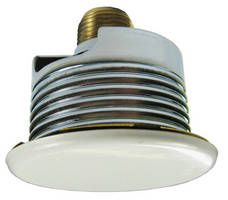NAMPA -- Firefighters want homeowners to consider something beyond smoke detectors for fire safety. They hope more people will consider installing fire sprinklers. The Nampa and Caldwell Fire Departments showed why that is with a demonstration at a training facility.
The Nampa Fire Department set up a demonstration with two "burn cells" made to look like two living rooms. Fire experts say around 40 percent of deadly fires
start in the living room, so it makes a realistic demonstration.
One of the cells was equipped with one smoke detector and one fire sprinkler, the other with just a smoke detector. A volunteer lit newspaper on fire and tucked it between the couches in each cell.
In both, the smoke detectors went off around 20 to 30 seconds after the fire start. At 155 degrees (measured at the ceiling), the fire sprinkler went off in one cell and suppressed the fire.
"The intention of these systems is to allow people to survive. To get you out," Nampa Deputy Chief Doug Strosnider explained.
In the other cell, the fire grew quickly and by a minute and a half into the fire, flames were exploding out of the cell and thick black smoke poured out. That fire reached more than 1,000 degrees before firefighters manually extinguished the fire.
"The smoke detector did melt and drop, and as you guys saw, 1,200 degrees. Nobody's going to survive this. It's not a survivable event," Strosnider explained, standing inside the badly charred cell.
Fire officials explained another big difference in having sprinklers: Water damage versus fire damage.
"Things dry out. So if you have water, and say you have family pictures or whatever you've got here. They dry out. They don't unburn," Strosnider said.
On average, fire officials say a fire costs $60,000-70,000, but
water damage from a sprinkler or two going off is usually $5,000-$6,000. Usually only one or two sprinklers end up activating, contrary to some misconceptions, say officials.
"The damage, there is no argument. It's so much worse on a fire. And you lose everything you've ever owned, and possibly your loved ones," Caldwell Fire Marshal Andy Cater said.
The fire demonstration helps explain why when they built their house, Caldwell Fire Chief Mark Wendelsdorf's family became the first in town to install
residential fire sprinklers in a single family home.
"We want to protect our family. We want to protect our investment in our house, and this is a simple way of doing it. Especially when you're building a new home, now is the time to do it," Wendelsdorf said.
The sprinklers are throughout their home. In all, they have more than two dozen everywhere from bedrooms to the garage to closets.
"You can hardly see them, they're just covered and they'll just drop down if they need to," Christine McPartlan, a 911 Dispatcher, said.
The sprinkler system cost extra, several thousand dollars, or around $2 a square foot. However, their insurance is 10 percent cheaper because of the sprinklers, and they say you can't put a price on the sprinklers protecting a home and family.
"I see more death and destruction in a year than people see in a whole lifetime. Going to somebody who's lost everything, all their photos, their
wedding albums, their wedding rings. Everything they've worked for their whole life is gone literally in minutes. And it can all be saved by a simple $2 a square foot investment," Wendelsdorf said.
Cater said it's easiest to install sprinklers while building, but it is possible to retro-fit a home with sprinklers.
The Caldwell Chief says Idaho's legislature has chosen to make fire sprinklers optional when building, even though national codes actually require them. He hopes that will change.
The Idaho Falls Fire Marshal says that just this week sprinklers saved a senior housing complex and the people living there. By the time crews got there, all they found was a resident who was wet and water left by the one sprinkler that went off in the kitchen, where the fire started.
"The activation of the fire sprinkler prevented a much larger fire from occurring and protected the occupant and his companion pet from a potentially dangerous fire," said Idaho Falls Fire Marshal Ken Anderson. "Other residents in the building were also protected from heat and smoke because the fire had not progressed as would be the case if the fire sprinkler system was not installed."






